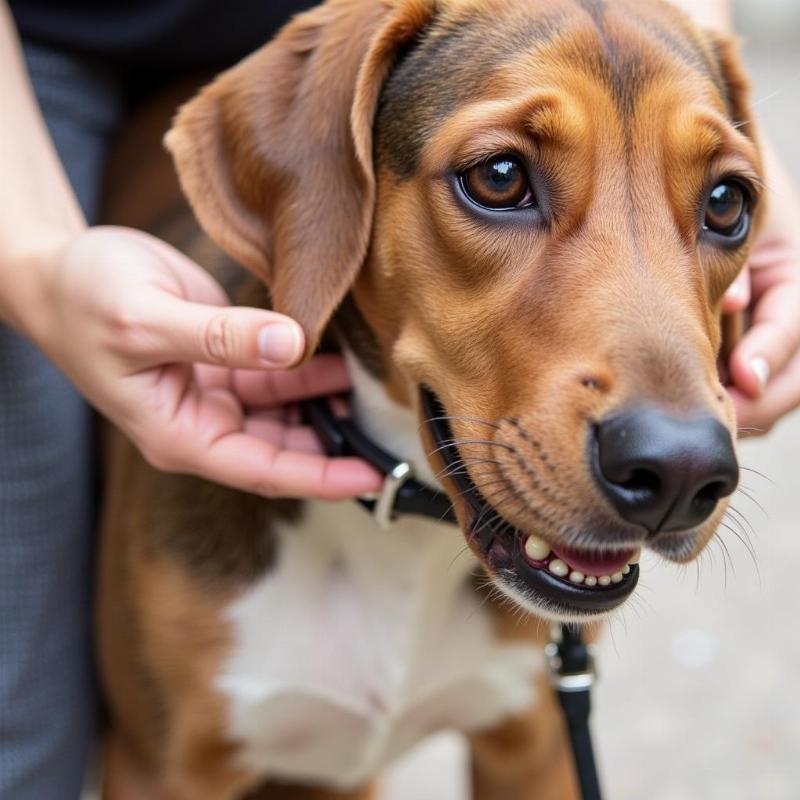Putting on a dog leash seems simple enough, right? But for new dog owners, or even experienced ones with a particularly wriggly pup, it can be a surprising challenge. Properly leashing your dog isn’t just about getting them outside; it’s a crucial aspect of their safety, your peace of mind, and building a positive relationship. A properly fitted leash and a calm, confident approach are key to making leash time a happy experience for both of you.
Understanding the Importance of a Properly Fitted Leash
Before we dive into the “how-to,” let’s talk about “why” it matters. A leash that’s too tight can choke your dog, restrict their movement, and even cause injuries. A leash that’s too loose, on the other hand, can be a safety hazard, allowing your dog to slip out and potentially run into traffic or get into other dangerous situations. Finding the right balance is essential for a safe and enjoyable walk. Beyond safety, the process of putting on the leash should be a positive experience, fostering trust and strengthening the bond between you and your furry friend.
Choosing the Right Leash and Collar
The first step in mastering the art of leashing your dog is selecting the appropriate equipment. There are various types of leashes available in the US market, from standard nylon leashes to retractable ones, and even specialized training leashes. Consider your dog’s size, breed, and temperament when making your choice. Likewise, the collar is just as important. A flat collar is a common choice, but harnesses can be a better option for dogs who pull or are prone to tracheal collapse. For small breeds, a harness can distribute pressure more evenly and prevent injury.
Step-by-Step Guide: How to Put on a Dog Leash
Here’s a simple, step-by-step guide to putting on a dog leash:
- Introduce the leash positively: Let your dog sniff and investigate the leash before attempting to put it on. Pair the leash with positive reinforcement like treats or praise.
- Position your dog: Have your dog sit or stand calmly. This might require some initial training, but it will make the process much easier.
- Attach the leash to the collar: For a flat collar, ensure the leash is attached securely and that it’s not twisted. For a harness, make sure all straps are properly fastened and adjusted for a snug but comfortable fit. Two fingers should fit comfortably between the harness and your dog’s body.
- Check the fit: Ensure the collar or harness is not too tight or too loose. You should be able to comfortably fit two fingers between the collar and your dog’s neck.
 Checking the fit of a dog's leash
Checking the fit of a dog's leash
Troubleshooting Common Leash-Related Issues
- My dog pulls on the leash: Consider using a harness or a no-pull harness designed to discourage pulling. Consult with a certified dog trainer for guidance on loose-leash walking techniques.
- My dog is afraid of the leash: Desensitize your dog to the leash gradually. Start by leaving it near their food bowl or toys, then progress to briefly touching them with the leash before attaching it. Positive reinforcement is key.
Expert Insights
“Many behavioral issues, like pulling on the leash, stem from a lack of proper training and socialization,” says Dr. Emily Carter, DVM, a veterinarian based in California. “Starting early and making the experience positive is crucial for a well-behaved dog on a leash.”
Conclusion
Putting on a dog leash is more than just a precursor to a walk; it’s an opportunity to build a positive association with the experience and reinforce your bond with your furry friend. By following these simple steps and choosing the right equipment, you can make leash time a safe, enjoyable experience for both of you.
FAQ
- What type of leash is best for a puppy? A lightweight, standard nylon leash is a good starting point for a puppy.
- How tight should a dog’s collar be? You should be able to fit two fingers comfortably between the collar and your dog’s neck.
- My dog chews on the leash. What can I do? Try using a bitter apple spray or offer a chew toy as a distraction.
- Is it okay to use a retractable leash? Retractable leashes can be convenient, but they can also present safety hazards. Use caution and consider the environment.
- How can I teach my dog to walk calmly on a leash? Consistent training and positive reinforcement are essential for loose-leash walking.
- What if my dog refuses to wear a collar? Gradually introduce the collar with positive reinforcement. Start with short periods of wear and reward your dog for accepting it.
- When should I start leash training my puppy? You can start leash training as early as 8 weeks old.
Introducing Beautdogs.us
Beautdogs.us is your premier destination for all things dog-related in the US. We offer expert advice on dog breeds, care, and lifestyle, providing reliable information for both novice and seasoned dog owners. From product reviews to training tips, we’re here to help you navigate the wonderful world of dog ownership. Contact us at [email protected] or +1 501-555-7529 to learn more.